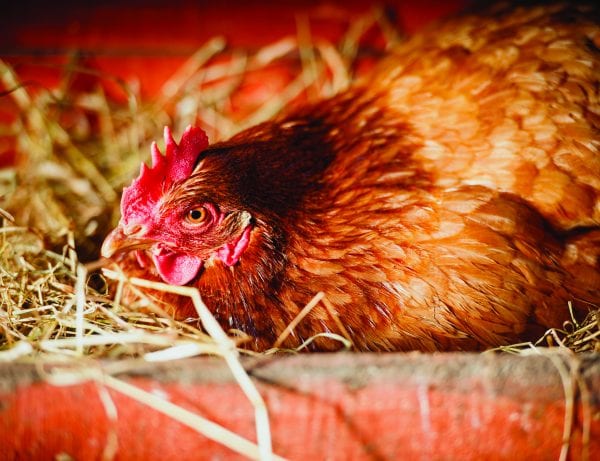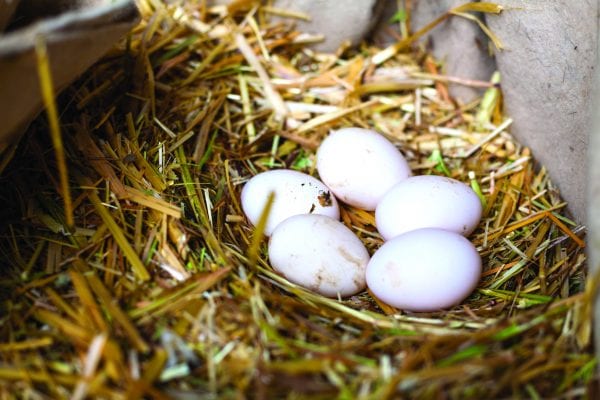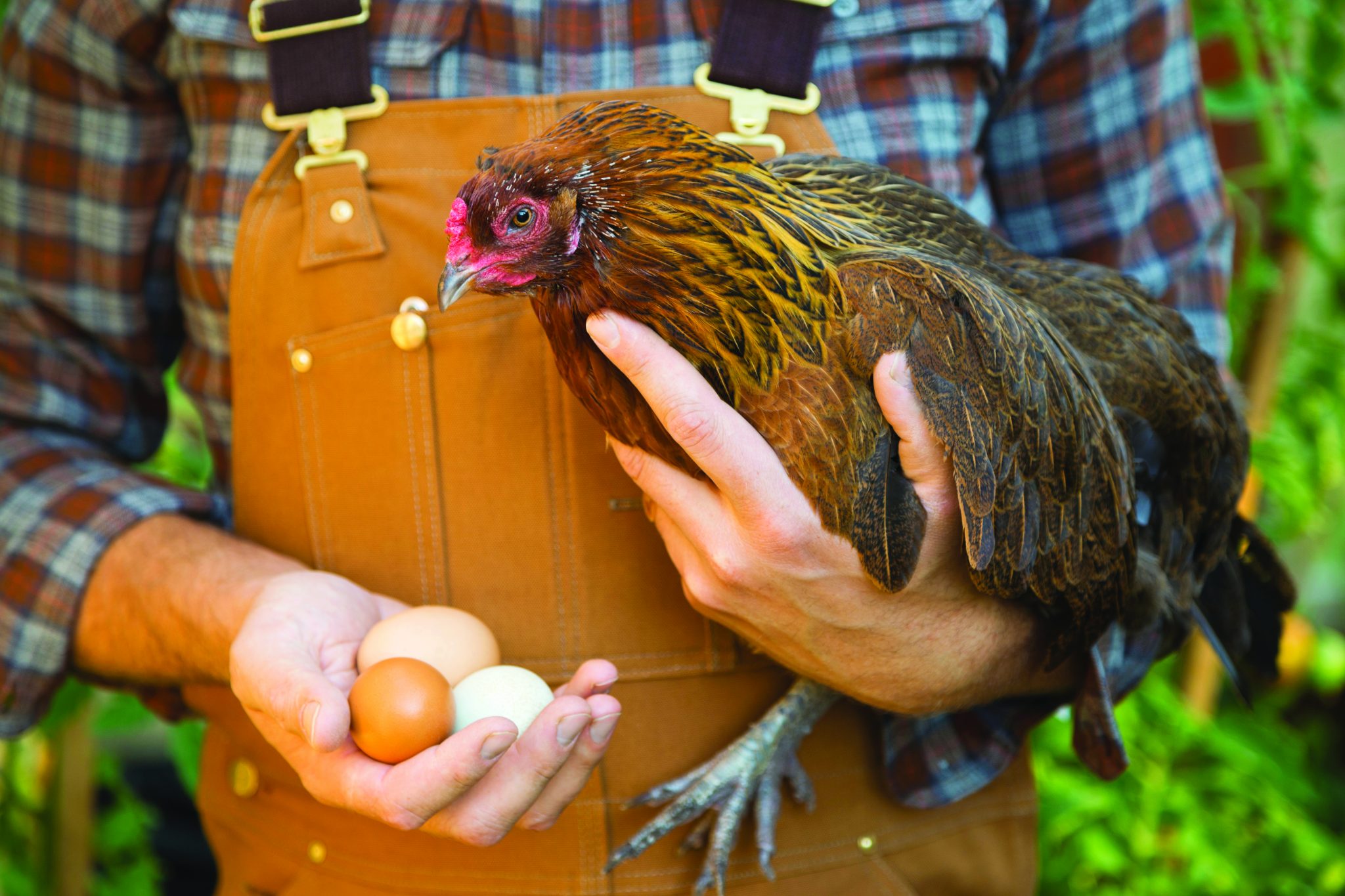Farming

Best practices for managing your home layer flock include tips for brooding, development, lighting, biosecurity, disease control, and more.
Management of Young (Pullet) Laying Stock
Brooding
Small chicks cannot control their body temperature and must be babied from day old until 2 to 4 weeks old or until they have some feather cover. Provide a heat source (heat lamp) with feed and water close at hand. Confine the birds in such a way that they can move closer to the heat or farther away to regulate their comfort. Brooding setups are normally small, however, so that chicks do not wander too far from the heat. Birds may be brooded in a small space (1⁄2 foot2 per bird) for the first several weeks. Feeder space for brooding is 1 linear inch/bird during brooding. One quart jug-type water will be sufficient if only a few birds are brooded. If larger groups (15 to 50 birds) are started, a gallon jug- type waterer will be needed.
Development
Once the birds are old enough to grow and prosper without brooding, it is important to give them sufficient space, clean water, and clean, dry feed. Birds started on a raised wire floor will stay cleaner than birds on the ground, and they are less likely to reinfect themselves if they have had an intestinal disease. If you house birds on grass, they will very quickly be housed on dirt (they eat the grass). It may be wise to put down a thick layer of pea gravel to help keep the birds cleaner. Straw or pine bark, in place of the pea gravel, will help keep mud from becoming as much of a problem, but will not provide as clean an environment. House birds at 2 feet2 per bird as they get older.
Management of Birds in Lay
 Hens require shelter, room to move and interact with each other, and access to clean food and water to prosper. Provide one nest box (12ʺx12ʺx12ʺ) per four hens to keep birds laying eggs in the boxes and not on the ground. Shelter should provide an escape from sun, wind, and rain. Birds will normally roost in the shelter at night, so perches may be provided in the shelter. Provide 2 to 4 feet2 per bird for adult laying hens. Gather eggs at least once per day. Twice a day would be better in hot weather.
Hens require shelter, room to move and interact with each other, and access to clean food and water to prosper. Provide one nest box (12ʺx12ʺx12ʺ) per four hens to keep birds laying eggs in the boxes and not on the ground. Shelter should provide an escape from sun, wind, and rain. Birds will normally roost in the shelter at night, so perches may be provided in the shelter. Provide 2 to 4 feet2 per bird for adult laying hens. Gather eggs at least once per day. Twice a day would be better in hot weather.
Lighting
Starting chicks in the spring is not conducive to maximum egg laying in hens. Ideally, pullets would be raised on short days (fall and winter), then brought into lay on a natural lengthening light schedule (spring and summer). Nature does not help us in this regard, but we can add some light in the fall and winter to maintain a longer day length (14 to 16 hours) and stimulate egg production. Normally, a low wattage light bulb (5 to 25 watts) can be installed in the pen to shine from 4 p.m. to 8 p.m. (increasing day length enough to keep egg production strong) to inexpensively avoid this problem.
Cannibalism
Chickens do not respond kindly to weakness in others. In any flock, there will be one bird at the bottom of the pecking order that attracts the majority of the bullying. It may be wise to have a small hospital pen for removing birds that are sick or injured, so they may have a chance to recover without further harassment. Allowing enough square footage per bird of pen space (2 feet2 per bird) will help reduce conflict, but will not eliminate the problem completely. Installing perches in the roosting area may allow birds to get up and away from others as well.
Feeding Pullets and Layers
General
Place feeders and waterers in a covered location out of the sun and rain to maintain feed quality. Feed from some type of feeder; do not broadcast feed on the ground. Have clean, dry feed available at all times. If you feel you must give scratch grains or table scraps as a treat, severely limit the amount of either to make sure that the birds eat plenty of the commercial feed. An imbalanced diet (too much grains or scraps) reduces growth and may allow diseases to get started.
Pullets
The most common feed available in the local feed and seed store will be a starter-grower feed. This feed is designed to be fed free choice (available at all times) and should be the only thing fed. Do not mix with corn or scratch grain mixes. Do not feed laying hen mash to these birds as the high level of calcium will damage the younger birds’ kidneys. Feed starter-grower until egg production starts at 17 to 20 weeks of age. Once egg laying starts, switch to laying mash. Raise feeders and waterers off the ground so that each stays clean. Clean waterers regularly, and replace water regularly as well. Provide 2 1⁄2 linear inches of feeder space and 1 linear inch of waterer space per bird after brooding.
Laying Hens
Feed layer mash from the appearance of the first egg. Have feed available in a covered, dry feeder at all times. Don’t offer more feed than the birds will eat in several days as feed will become stale if left in the outdoors for too long. But don’t leave birds without feed for an extended time either. Also, don’t buy too much feed at one time unless you have an air-conditioned place to store it. Store feed in a tightly lidded container off the floor. Most people with small layer flocks provide oyster shell for extra calcium in a separate feeder to help keep shells strong. Raise feeders and waterers off the ground so that each stays clean (a square made of 2x4s slightly larger than the feeder/waterer with a hardware cloth top will allow feed/water to spill without the birds getting into it). Clean waterers regularly and replace water regularly as well. Provide 2 1⁄2 linear inches of feeder space and 1 linear inch of waterer space per bird.
Disease Control and Biosecurity
Prevention
 Respiratory and intestinal diseases are not uncommon in small home flocks. The first line of defense in maintaining healthy birds is to buy chicks that have been vaccinated for common diseases, such as Marek’s disease and Newcastle disease. After delivery, proper brooding conditions will help avoid early disease problems. Older birds housed outdoors will be exposed to diseases through contact with birds such as sparrows and starlings that drink and eat from their pens. This is difficult to control.
Respiratory and intestinal diseases are not uncommon in small home flocks. The first line of defense in maintaining healthy birds is to buy chicks that have been vaccinated for common diseases, such as Marek’s disease and Newcastle disease. After delivery, proper brooding conditions will help avoid early disease problems. Older birds housed outdoors will be exposed to diseases through contact with birds such as sparrows and starlings that drink and eat from their pens. This is difficult to control.
Older birds tend to have stronger immune systems and may fight off a disease organism without showing signs. These birds may be carriers of the disease, however, and younger birds introduced into an established flock may show the disease after a few days or weeks. For that reason, it is important to quarantine any new birds in a separate pen 10 to 14 days before introducing them to the established flock. This serves two purposes: (1) it will reduce stress on the new birds being introduced into the flock, which decreases the chance of a disease taking hold and (2) if new birds are bringing a disease with them, they will show signs in that 10 to 14 day time frame.
Treatment
Many people offer a broad-spectrum antibiotic in the birds’ water for 3 to 7 days if sick birds are present. Take care to save and dispose of eggs laid by the hens during and after the antibiotic has been administered as some people are allergic to individual antibiotics. Periods in which eggs need to be destroyed rather than eaten vary with antibiotic, so follow label directions. Antibiotics will not reduce a viral infection but will keep secondary bacterial infections from taking hold. Consult a veterinarian or the closest Alabama State Veterinary Diagnostic Lab (Auburn, Boaz, Hanceville, or Opp) if a disease appears to be affecting a number of birds.
Predators
Predators are frequently a problem with small poultry flocks. Both air-based and ground-based predators must be considered when securing pens for your birds. If a poultry run is planned, it may be covered with inexpensive (plastic) deer netting to keep out hawks and owls. Sturdy wire sides will help keep out opossums, skunks, and domestic cats, although domestic dogs and coyotes may bite through wire. It may be necessary to bury 12 to 18 inches of the wire into the ground to discourage digging under the wire fence. It can be difficult to protect young chicks from snakes unless they are kept in some kind of building. Older birds are generally too large for a snake to consider as food, although some snakes will eat eggs.
Joseph B. Hess, Extension Specialist, Professor, Poultry Science; Ken S. Macklin, Extension Specialist, Professor, Poultry Science; and J. B. Blake, former Extension Specialist, all with Auburn University
Reviewed May 2022, Home Layer Flock Management Suggestions, ANR-2549

